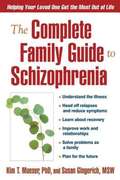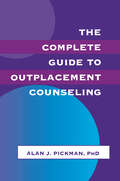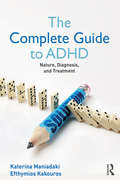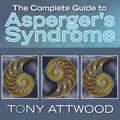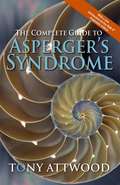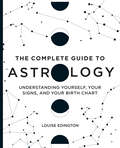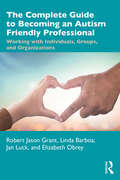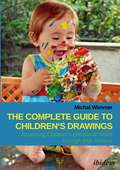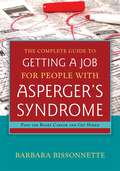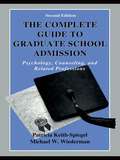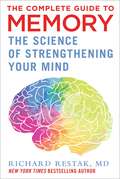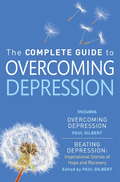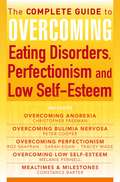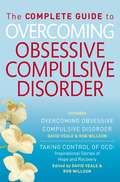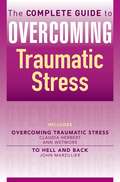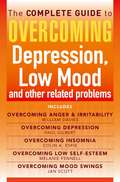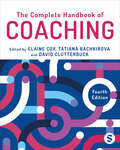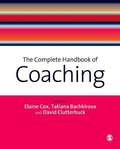- Table View
- List View
The Complete Family Guide to Schizophrenia
by Susan Gingerich Kim T. MueserWill the person you love ever get better? Chances are you've grappled with the question. With care and support from their families, people with schizophrenia can and do make vast improvements. Noted therapists Kim Mueser and Susan Gingerich deepen your understanding of the illness and cover a wide range of effective treatments. Based on decades of research and experience, they offer pragmatic suggestions for dealing with depression, psychosis, and other symptoms. They show you how to prioritize needs, resolve everyday problems, and encourage your loved one to set life goals. Plus, individual sections highlight special issues for parents, children, siblings, and partners. Whether you're facing schizophrenia for the first time or you've dealt with its impact for years, you'll discover innovative ways to handle challenges that arise over the course of treatment, from reducing the chances of relapse to making friends and finding work. Recovery isn't an endpoint--it's a lifelong journey. With love, hope, and realistic optimism, striving for it can lead to a richer, more rewarding life for your entire family. Winner, NAMI/Ken Book Award
The Complete Family Guide to Schizophrenia: Helping Your Loved One Get the Most Out of Life
by Kim Mueser Susan GingerichWill the person you love ever get better? Chances are you've grappled with the question. With care and support from their families, people with schizophrenia can and do make vast improvements. Noted therapists Kim Mueser and Susan Gingerich deepen your understanding of the illness and cover a wide range of effective treatments. Based on decades of research and experience, they offer pragmatic suggestions for dealing with depression, psychosis, and other symptoms. They show you how to prioritize needs, resolve everyday problems, and encourage your loved one to set life goals. Plus, individual sections highlight special issues for parents, children, siblings, and partners. Whether you're facing schizophrenia for the first time or you've dealt with its impact for years, you'll discover innovative ways to handle challenges that arise over the course of treatment, from reducing the chances of relapse to making friends and finding work. Recovery isn't an endpoint--it's a lifelong journey. With love, hope, and realistic optimism, striving for it can lead to a richer, more rewarding life for your entire family.
The Complete Guide To Outplacement Counseling
by Alan J. Pickman Alan J. Pickman, PhDRecognized by business managers as a useful and practical tool to assist them in responding to a set of complex business challenges, the need for outplacement counseling-- the process of assisting employees who have lost their jobs to develop effective career plans and to find new employment --has grown dramatically during the past two decades. Given this rapid expansion of the field, assembling, organizing, and clarifying the body of knowledge and information available about outplacement has become critically important. The first comprehensive effort in the field, this book presents authoritative, up-to-date information on an exhaustive range of outplacement topics. A psychologist and experienced outplacement practitioner, the author has recently been chosen as one of the charter fellows of the Outplacement Institute, the sole certifying organization for outplacement practitioners. Of value to all those interested in the field including current and future practitioners as well as human resources professionals, this volume contains essential information for candidates receiving outplacement services, counseling students, and researchers involved in the study of counseling in business and industry. With such a broad audience in mind, it contains a wide range of information--counseling theory and practical suggestions geared expressly to the needs of practitioners, descriptive material on all topics, and brief case histories of actual outplacement candidates. Written in non-technical language, the volume brings to life the flavor of outplacement practice. This unique volume covers topics not addressed elsewhere in the current outplacement literature including: *the psychological barriers to a successful job search, *the behavioral and counseling implications of the outplacement setting, *the theoretical basis of outplacement counseling, *the relation between outplacement and psychotherapy, *the professional development opportunities for outplacement practitioners, *the supervision of outplacement practitioners, *the cross-cultural issues to be considered in outplacement, *the relation of outplacement to other career development professionals, and *the marketing of outplacement services. Also of importance, the appendices offer data not previously disseminated to the general public including: *competencies standards for OPC practitioners as established by the International Association of Outplacement Professionals (IAOP), *standards of ethical practice for outplacement professionals as established by the IAOP, and *listings of information resources for OPC practitioners and candidates featuring a section on computer-based sources for conducting career-related research.
The Complete Guide to ADHD: Nature, Diagnosis, and Treatment
by Katerina Maniadaki Efhymios KakourosThis exciting new resource offers a comprehensive guide to ADHD, the most frequently diagnosed neurodevelopmental disorder and one of the most researched areas in child mental health. It brings together high-level research with the latest scholarship and applies them to practice, providing a unique and innovative perspective. Inside readers will find a critical presentation of current scientific knowledge regarding the nature, etiology, diagnosis, and management of the disorder. The book covers ADHD from infancy to adulthood and presents the whole range of possible comorbidities. The authors explore the topic from the perspective of researchers, academics, and clinicians while also offering a structured assessment procedure, a complete early intervention and treatment program, as well as illuminative case studies and practical tools for educators.
The Complete Guide to Asperger's Syndrome
by Dr Anthony AttwoodThe Asperger's Syndrome Bible for parents and professionals, newly updated with an introduction explaining the DSM-5The Complete Guide to Asperger's Syndrome is the definitive handbook for anyone affected by Asperger's syndrome (AS). Now including a new introduction explaining the impact of DSM-5 on the diagnosis and approach to AS, it brings together a wealth of information on all aspects of the syndrome for children through to adults.Drawing on case studies and personal accounts from Attwood's extensive clinical experience, and from his correspondence with individuals with AS, this book is both authoritative and extremely accessible. Chapters examine: * causes and indications of the syndrome * the diagnosis and its effect on the individual * theory of mind * the perception of emotions in self and others * social interaction, including friendships * long-term relationships * teasing, bullying and mental health issues * the effect of AS on language and cognitive abilities, sensory sensitivity, movement and co-ordination skills * career development.There is also an invaluable frequently asked questions chapter and a section listing useful resources for anyone wishing to find further information on a particular aspect of AS, as well as literature and educational tools.Essential reading for families and individuals affected by AS as well as teachers, professionals and employers coming in contact with people with AS, this book should be on the bookshelf of anyone who needs to know or is interested in this complex condition.'I usually say to the child, "Congratulations, you have Asperger's syndrome", and explain that this means he or she is not mad, bad or defective, but has a different way of thinking.'- from The Complete Guide to Asperger's Syndrome(P) 2019 Hodder & Stoughton Ltd
The Complete Guide to Asperger's Syndrome
by Tony AttwoodDefinitive guide presenting latest information from an expert in easy-to-read English.
The Complete Guide to Asperger's Syndrome
by Tony AttwoodThe Complete Guide to Asperger's Syndrome is the definitive handbook for anyone affected by Asperger's syndrome (AS). Now including a new introduction explaining the impact of DSM-5 on the diagnosis and approach to AS, it brings together a wealth of information on all aspects of the syndrome for children through to adults. Drawing on case studies and personal accounts from Attwood's extensive clinical experience, and from his correspondence with individuals with AS, this book is both authoritative and extremely accessible. Chapters examine: * causes and indications of the syndrome * the diagnosis and its effect on the individual * theory of mind * the perception of emotions in self and others * social interaction, including friendships * long-term relationships * teasing, bullying and mental health issues * the effect of AS on language and cognitive abilities, sensory sensitivity, movement and co-ordination skills * career development. There is also an invaluable frequently asked questions chapter and a section listing useful resources for anyone wishing to find further information on a particular aspect of AS, as well as literature and educational tools. Essential reading for families and individuals affected by AS as well as teachers, professionals and employers coming in contact with people with AS, this book should be on the bookshelf of anyone who needs to know or is interested in this complex condition. 'I usually say to the child, "Congratulations, you have Asperger's syndrome", and explain that this means he or she is not mad, bad or defective, but has a different way of thinking.' - from The Complete Guide to Asperger's Syndrome
The Complete Guide to Astrology: Understanding Yourself, Your Signs, and Your Birth Chart
by Louise EdingtonAn essential guide to astrology for both beginner and advanced practitionersAstrology has been used for thousands of years to help predict events, understand the meaning of life, and teach people to communicate more effectively with others. Whether you are new to the field or have long been looking to astrology for answers, The Complete Guide to Astrology will help you unlock the wisdom of the stars.Start with the basic elements of astrology like the signs, modalities, and houses. Then, learn how to structure, interpret, and take a closer look at your birth chart. From there, detailed charts give you further insight into how to live up to your highest potential at work and in relationships.This astrology book for adults includes:An introduction to astrology essentials—Learn the foundations of astrology, including its historical origins and its context in modern society.Wisdom beyond your sun sign—Explore the more complex astrological associations on your birth chart, including nodes, moon signs, the influences of planets, and more.Astrology for everyone—Discover an open-minded approach to astrological concepts that helps make the wisdom of the cosmos accessible.Understand how your stars align with The Complete Guide to Astrology.
The Complete Guide to Becoming an Autism Friendly Professional: Working with Individuals, Groups, and Organizations
by Robert Jason Grant Linda Barboa Jan Luck Elizabeth ObreyBased on the award-winning Autism Friendly Training Program, created by the non-profit organization STARS for Autism, this book empowers the everyday professional to a better understanding and skill in working with, interacting with, serving, and teaching children and adults who have autism spectrum disorder (ASD). After a thorough explanation of ASD and how it affects children, adults, families, and communities, this guide describes the Autism Friendly Training Program and gives the reader insight into what it means to become autism friendly and to be an autism friendly training presenter. This text will enable those who are neurotypical to gain insight into the person, the stories, and the lives of those with ASD. It is a guide to understanding autism at a deeper level to enable relationship and support processes that define being autism friendly. Providing the needed information, tools, and confidence to be autism friendly, this book will be beneficial to any and all businesses, organizations, groups, communities, families, and individuals who work with, serve, interact with, teach, parent, and experience life with an autistic person.
The Complete Guide to Children's Drawings: Accessing Children's Emotional World Through Their Artwork
by Michal WimmerThis indispensable guide for both parents and professionals offers fascinating ways to better understand the emotional world of children and what is important to them as represented by their drawings. It presents cases of children and adolescents coping with a variety of life challenges and clinical issues by way of interpreting their artwork. Parents, educators, clinicians, and doctors will find this practical guide highly beneficial for understanding children's strengths, weaknesses, and the reasons for their behavior in cases of ADHD, fears and anxiety, coping with divorce, stubbornness and power struggles, sibling rivalry, difficulties with weaning, tantrums, a new baby in the family, learning disabilities, obesity, a lack of emotional intelligence, and many more. The book can also effectively aid them in initiating a fruitful emotional dialogue based on specific insights from the drawings.The wisdom in this book is based on extensive psychological studies, innovative independent research, and vast clinical experience. Using over 250 real-life examples of children's drawings, Wimmer offers more than 100 effective coping tools and solutions inspired by this artwork that can be extremely useful in enhancing children's self-confidence and family relationships.
The Complete Guide to Getting a Job for People with Asperger's Syndrome: Find the Right Career and Get Hired
by Barbara BissonnetteFinding a job is a confusing and anxiety-provoking process for many individuals with Asperger's Syndrome (AS) who may not know what they are qualified to do and may struggle to communicate their value to employers. In this book, Asperger's employment expert Barbara Bissonnette describes exactly what it takes to get hired in the neurotypical workplace. Every aspect of finding employment is covered, from defining strengths and researching occupations, to marketing oneself and projecting confidence and enthusiasm in interviews. Job-hunters are taught how to develop a personal profile of their talents and skills, their ideal work environment, and important work criteria. They are then shown how to set realistic goals and develop an effective job search plan. There is detailed instruction on networking, including how to find contacts and what to say. A wealth of checklists, templates, sample scripts and written communications accompany the text. Upfront, engaging and highly practical, this will be an essential guide for individuals with AS entering the workforce for the first time, as well as experienced workers who have lost jobs or wish to change careers but are uncertain about how to find the best match for their abilities.
The Complete Guide to Graduate School Admission: Psychology, Counseling, and Related Professions
by Patricia Keith-Spiegel Michael W. WiedermanShould I go to graduate school? How do I choose where to apply? Are my grades and accomplishments good enough to get in? Who should I ask to write recommendation letters for me, and how should I approach these people? How do I write my "personal statement?" When will I hear my fate, and how should I make my final decision? These are just a few of the many questions to which this well-researched, thorough, and extremely user-friendly book offers answers. Students who are contemplating graduate training in psychology, counseling, and related fields are often apprehensive and confused about applying to graduate school, but this book takes the guesswork and anxiety out of the process. The tone and features (such as the Q&A format, timeline for application-related tasks and activities, and special advice for special populations) that made the first edition so successful, eliciting hundreds of thank-you notes and e-mail messages to the author, are just as evident in this new edition. The book has been thoroughly updated to include coverage of new topics such as use of the internet and e-mail, as well as changing trends in the professions. The most obvious difference is that the book is now significantly shorter as a result of meticulous rewriting, making it even easier to use. There have been attempts since the publication of the first edition to copy the format of this book, but none of the others have successfully duplicated the depth of research-based advice and the supportive style that make this book the guide of choice for thousands of graduate-school bound students and their advisors.
The Complete Guide to Memory: The Science of Strengthening Your Mind
by Richard RestakA comprehensive guide to understanding how memory works, how memory forms, the mind-body connection, and more! In the busy, information-filled world in which we live, it&’s often easy to forget things and hard to keep track of how details get stored in our brain. The Complete Guide to Memory serves to provide a one-stop resource that covers the essentials on memory. World-renowned memory expert, Dr. Richard Restak, addresses the following topics in detail: How memories formThe different kinds of memoryChanges in brain structureThe mind-body connectionThe relationship between memory and emotional regulationAnd much more! With tips and tricks to manage memory well for people of all ages and personal examples of the techniques used, this book leaves no stone unturned.
The Complete Guide to Overcoming Depression: (ebook bundle)
by Paul GilbertThe bestselling self-help guide Overcoming Depression has been combined with Beating Depression: Inspirational stories of hope and recovery to offer the reader an effective and appealing self-help package. These two titles not only set out practical techniques to overcome depression, but offer inspiration to the reader to confront the challenges they may face on the road to recovery.Overcoming Depression is based on Cognitive Behavioral Therapy (CBT), an evidence-based therapy recommended by the NHS. It provides:-Useful information about the disorder-A step-by-step self-help programme based on CBTBeating Depression contains real-life stories written by those with first-hand experience of depression, including postnatal depression and bipolar disorder. Each story sheds light on the condition, and offers powerful insights into what helps and, most importantly, inspiration to those trying to beat it.
The Complete Guide to Overcoming Depression: (ebook bundle)
by Prof Paul GilbertThe bestselling self-help guide Overcoming Depression has been combined with Beating Depression: Inspirational stories of hope and recovery to offer the reader an effective and appealing self-help package. These two titles not only set out practical techniques to overcome depression, but offer inspiration to the reader to confront the challenges they may face on the road to recovery.Overcoming Depression is based on Cognitive Behavioral Therapy (CBT), an evidence-based therapy recommended by the NHS. It provides:-Useful information about the disorder-A step-by-step self-help programme based on CBTBeating Depression contains real-life stories written by those with first-hand experience of depression, including postnatal depression and bipolar disorder. Each story sheds light on the condition, and offers powerful insights into what helps and, most importantly, inspiration to those trying to beat it.
The Complete Guide to Overcoming Eating Disorders, Perfectionism and Low Self-Esteem (ebook bundle)
by Roz Shafran Constance Barter Tracey Wade Sarah Egan Dr Christopher Freeman Dr Melanie Fennell Prof Peter CooperEating disorders, such as anorexia nervosa, bulimia nervosa and binge and disordered eating, affect a significant proportion of the general population. They can cause untold suffering to those with the disorder, and those around them, who find themselves at a loss how to help their loved one. For the first time, this unique bundle combines hope and inspiration to those experiencing eating disorders either first-hand or up close. Includes: self-help programmes for the eating disorders and the inspirational diary of recovery written by an ex-sufferer of Anorexia Nervosa, now a Youth Ambassador for Beat, the Eating Disorders association.Includes the following: Overcoming Anorexia Overcoming Bulimia Nervosa & Binge-Eating Overcoming Perfectionism Overcoming Low Self-Esteem Mealtimes & Milestones
The Complete Guide to Overcoming OCD: (ebook bundle)
by Rob Willson David VealeThe bestselling self-help guide Overcoming Obsessive Compulsive Disorder has been combined with Taking Control of OCD: Inspirational stories of hope and recovery to offer the reader an effective and appealing self-help package. These two titles not only set out practical techniques to overcome obsessive Compulsive Disorder (OCD), but offer inspiration to the reader to confront the challenges they may face on the road to recovery.Overcoming Obsessive Compulsive Disorder is based on Cognitive Behavioral Therapy (CBT), an evidence-based therapy recommended by the NHS. It provides:-Useful information about the disorder-A step-by-step self-help programme based on CBTTaking Control of OCD contains real-life stories written by those with first-hand experience of OCD. Each story has been especially selected by Dr David Veale and Rob Willson and together they reflect the broad range of different experiences and stories of OCD. Each story sheds light on the condition, and offers powerful insights into what helps and, most importantly, inspiration to those trying to beat it.
The Complete Guide to Overcoming OCD: (ebook bundle)
by Rob Willson David VealeThe bestselling self-help guide Overcoming Obsessive Compulsive Disorder has been combined with Taking Control of OCD: Inspirational stories of hope and recovery to offer the reader an effective and appealing self-help package. These two titles not only set out practical techniques to overcome obsessive Compulsive Disorder (OCD), but offer inspiration to the reader to confront the challenges they may face on the road to recovery.Overcoming Obsessive Compulsive Disorder is based on Cognitive Behavioral Therapy (CBT), an evidence-based therapy recommended by the NHS. It provides:-Useful information about the disorder-A step-by-step self-help programme based on CBTTaking Control of OCD contains real-life stories written by those with first-hand experience of OCD. Each story has been especially selected by Dr David Veale and Rob Willson and together they reflect the broad range of different experiences and stories of OCD. Each story sheds light on the condition, and offers powerful insights into what helps and, most importantly, inspiration to those trying to beat it.
The Complete Guide to Overcoming Traumatic Stress (ebook bundle)
by Claudia Herbert Ann Wetmore John MarzillierTerrible events are very hard to deal with. Those who go through a catastrophic life experience, such as a car accident, assault, long-term abuse, an illness or bereavement, often feel permanently changed by the impact of what has happened. They become numb and shut off from those around them, or grief or guilt may constantly weigh them down. Memories of horrifying scenes may intrude unexpectedly during waking hours while sleep may be disturbed by vivid, unpleasant dreams. These two practical guides on trauma and how to cope with its aftermath are written by internationally recognise trauma experts.Overcoming Traumatic Stress - Claudia Herbert & Ann WetmoreBased on cognitive behavioural therapy (CBT), this self-help guide offers a step-by-step programme to help you to understand your traumatic experience and how it's affecting you, and to start to rebuild your life. Traumatic stress responses, including Post-Traumatic Stress Disorder (PTSD) result from a person's coping mechanisms having been completely overwhelmed by a terrible experience. 'Flashbacks' may be so severe that sufferers may feel that they are losing their sanity and subsequently become ever more isolated in their distress. To overcome the effects of trauma it is necessary to change those reactions and begin to see events in a different light. This book demonstrates, with practical advice and tested exercises, how to find new, effective ways of coping with, and finally overcoming traumatic stress.To Hell and Back - John MarzillierIn this innovative and engaging book, world-renowned psychologist John Marzillier dovetails first-hand accounts from trauma sufferers with over 40 years of clinical practice to provide an honest, human description of how trauma affects us at the time and also after the event.Whether discussing accounts of terrorist bombings, natural disasters, road accidents or physical attacks, he looks at what these experiences do to us and offers practical and consoling advice - for both sufferers and their loved ones - on coping with the experience and developing resilience for the future.
The Complete Guide to Overcoming Traumatic Stress (ebook bundle)
by Claudia Herbert Ann Wetmore John MarzillierTerrible events are very hard to deal with. Those who go through a catastrophic life experience, such as a car accident, assault, long-term abuse, an illness or bereavement, often feel permanently changed by the impact of what has happened. They become numb and shut off from those around them, or grief or guilt may constantly weigh them down. Memories of horrifying scenes may intrude unexpectedly during waking hours while sleep may be disturbed by vivid, unpleasant dreams. These two practical guides on trauma and how to cope with its aftermath are written by internationally recognise trauma experts.Overcoming Traumatic Stress - Claudia Herbert & Ann WetmoreBased on cognitive behavioural therapy (CBT), this self-help guide offers a step-by-step programme to help you to understand your traumatic experience and how it's affecting you, and to start to rebuild your life. Traumatic stress responses, including Post-Traumatic Stress Disorder (PTSD) result from a person's coping mechanisms having been completely overwhelmed by a terrible experience. 'Flashbacks' may be so severe that sufferers may feel that they are losing their sanity and subsequently become ever more isolated in their distress. To overcome the effects of trauma it is necessary to change those reactions and begin to see events in a different light. This book demonstrates, with practical advice and tested exercises, how to find new, effective ways of coping with, and finally overcoming traumatic stress.To Hell and Back - John MarzillierIn this innovative and engaging book, world-renowned psychologist John Marzillier dovetails first-hand accounts from trauma sufferers with over 40 years of clinical practice to provide an honest, human description of how trauma affects us at the time and also after the event.Whether discussing accounts of terrorist bombings, natural disasters, road accidents or physical attacks, he looks at what these experiences do to us and offers practical and consoling advice - for both sufferers and their loved ones - on coping with the experience and developing resilience for the future.
The Complete Guide to Overcoming depression, low mood and other related problems (ebook bundle)
by Jan Scott Melanie Fennell Colin EspieThis exclusive ebook bundle comprises five practical self-help programmes based on cognitive behavioural therapy (CBT) from the bestselling Overcoming series. Perfect for anyone experiencing problems with low mood or depression and associated problems such as low self-esteem, anger or sleep problems. This is also the perfect resource for therapists.Each book includes:-Case studies-Practical exercises-Monitoring sheetsOvercoming Depression - 3rd editionIf you suffer from depression you are far from alone. Depression is very common, affecting over 300 million people around the world. Written by Professor Paul Gilbert OBE, internationally recognised for his work on depression, this highly acclaimed self-help book has been of benefit to thousands of people including sufferers, their friends and families, and those working in the medical profession.This fully revised third edition has been extensively updated and rewritten to reflect over ten years of new research on understanding and treating depression, particularly the importance of developing compassionate ways of thinking, behaving and feeling.Overcoming Mood SwingsMost people know what it is like to experience high or low spirits. For some individuals, however, emotional extremes can seriously disrupt their lives, either because they happen too frequently or because the mood swings are intense and are accompanied by other symptoms of depression or mania (often referred to as bipolar disorder).This practical self-help guide provides background information on depression and mania and offers tried and tested techniques that will help the reader identify and manage their mood more effectively, and achieve a more stable emotional state.Overcoming Low Self-EsteemA self-help classic, winning acclaim for its practical and user-friendly approach and now recommended on the National Health Service's self-help scheme known as Books on Prescription. This book will aid readers to understand what has caused their low self-esteem and, with this knowledge, break out of the vicious circle of negative self-image, learn the art of self-acceptance and alter their lives for the better.Overcoming Anger and IrritabilityAn invaluable self-help guide to managing a widespread behavioural problem. This is a practical self-help programme for those who find that they are spoiling the lives of both themselves and those around them with their almost constant irritability and flashes of bad temper. It will help the reader understand why such behaviour occurs and what can be done to prevent it.Overcoming InsomniaExtensive research conducted over 25 years has established Cognitive Behavioural Therapy (CBT) as the treatment of choice for insomnia. For the first time, proven CBT principles have been brought together by a world-renowned expert on insomnia in a comprehensive self-help manual. In a clear step-by-step approach, new patterns of relaxation, sleeping and waking are quickly learnt. Based on clinically proven techniques.
The Complete Guide to Overcoming depression, low mood and other related problems (ebook bundle)
by Colin Espie Dr Melanie Fennell Prof Paul Gilbert Dr William Davies Professor Jan Scott MD, FRCPsychThis exclusive ebook bundle comprises five practical self-help programmes based on cognitive behavioural therapy (CBT) from the bestselling Overcoming series. Perfect for anyone experiencing problems with low mood or depression and associated problems such as low self-esteem, anger or sleep problems. This is also the perfect resource for therapists.Each book includes:-Case studies-Practical exercises-Monitoring sheetsOvercoming Depression - 3rd editionIf you suffer from depression you are far from alone. Depression is very common, affecting over 300 million people around the world. Written by Professor Paul Gilbert OBE, internationally recognised for his work on depression, this highly acclaimed self-help book has been of benefit to thousands of people including sufferers, their friends and families, and those working in the medical profession.This fully revised third edition has been extensively updated and rewritten to reflect over ten years of new research on understanding and treating depression, particularly the importance of developing compassionate ways of thinking, behaving and feeling.Overcoming Mood SwingsMost people know what it is like to experience high or low spirits. For some individuals, however, emotional extremes can seriously disrupt their lives, either because they happen too frequently or because the mood swings are intense and are accompanied by other symptoms of depression or mania (often referred to as bipolar disorder).This practical self-help guide provides background information on depression and mania and offers tried and tested techniques that will help the reader identify and manage their mood more effectively, and achieve a more stable emotional state.Overcoming Low Self-EsteemA self-help classic, winning acclaim for its practical and user-friendly approach and now recommended on the National Health Service's self-help scheme known as Books on Prescription. This book will aid readers to understand what has caused their low self-esteem and, with this knowledge, break out of the vicious circle of negative self-image, learn the art of self-acceptance and alter their lives for the better.Overcoming Anger and IrritabilityAn invaluable self-help guide to managing a widespread behavioural problem. This is a practical self-help programme for those who find that they are spoiling the lives of both themselves and those around them with their almost constant irritability and flashes of bad temper. It will help the reader understand why such behaviour occurs and what can be done to prevent it.Overcoming InsomniaExtensive research conducted over 25 years has established Cognitive Behavioural Therapy (CBT) as the treatment of choice for insomnia. For the first time, proven CBT principles have been brought together by a world-renowned expert on insomnia in a comprehensive self-help manual. In a clear step-by-step approach, new patterns of relaxation, sleeping and waking are quickly learnt. Based on clinically proven techniques.
The Complete Handbook of Coaching
by Elaine Cox Tatiana Bachkirova David ClutterbuckThis fourth edition provides the most comprehensive guide to the field of coaching, exploring a range of coaching theories and approaches, genres and settings and professional issues. It supports trainees and professionals to identify and develop a personal style of coaching. Each chapter includes discussion questions to facilitate reflection on the topic, further reading suggestions and case studies that help trainees make the crucial link between theory and practice. Its three parts cover: The theoretical traditions underpinning coaching such as cognitive-behavioural, gestalt and existential Contexts and genres such as life, executive, peer, team and career coaching Professional issues such as ethics, supervision, continuing professional development, standards and mental-health issues. This Fourth Edition comes with a new chapter on Diversity and Inclusion in Coaching, updated content throughout on cross-cultural coaching and updated Further Reading. A new online Teaching Guide provides chapter teaching and assessment suggestions, videos and further reading to help support trainees’ learning. Thousands of practitioners and trainees across a variety of professions have been helped by this distinctive handbook. From those working in health to education, from business and management to psychology, this unique handbook is an invaluable resource for any coaching career.
The Complete Handbook of Coaching
by Elaine Cox Tatiana Bachkirova David ClutterbuckThis fourth edition provides the most comprehensive guide to the field of coaching, exploring a range of coaching theories and approaches, genres and settings and professional issues. It supports trainees and professionals to identify and develop a personal style of coaching. Each chapter includes discussion questions to facilitate reflection on the topic, further reading suggestions and case studies that help trainees make the crucial link between theory and practice. Its three parts cover: The theoretical traditions underpinning coaching such as cognitive-behavioural, gestalt and existential Contexts and genres such as life, executive, peer, team and career coaching Professional issues such as ethics, supervision, continuing professional development, standards and mental-health issues. This Fourth Edition comes with a new chapter on Diversity and Inclusion in Coaching, updated content throughout on cross-cultural coaching and updated Further Reading. A new online Teaching Guide provides chapter teaching and assessment suggestions, videos and further reading to help support trainees’ learning. Thousands of practitioners and trainees across a variety of professions have been helped by this distinctive handbook. From those working in health to education, from business and management to psychology, this unique handbook is an invaluable resource for any coaching career.
The Complete Handbook of Coaching
by Elaine CoxThis comprehensive guide to coaching explores a full variety of coaching theories, approaches and settings, and offers strategies for the reader to identify and develop a personal style of coaching. The book is divided into three parts: - Part One explores the theoretical traditions that underpin the foundation for coaching such as cognitive-behavioural, Gestalt and existential. - Part Two covers applied contexts, formats or types of coaching such as life, executive, peer, team and career coaching. - Part Three focuses on professional issues that impact the coach such as ethics, supervision, continuing professional development, standards and mental-health issues. Written by leading international authors, each chapter makes explicit links between theory and practice and generic questions will facilitate further reflection on the topic. There are also suggestions for reading, and short case studies. This is the first book to explore the differences between the theoretical perspectives of coaching and the links between these perspectives in relation to contexts, genres and media of coaching.
